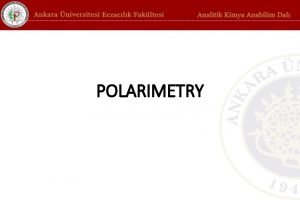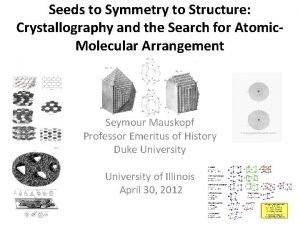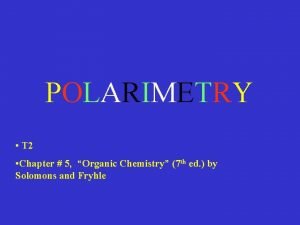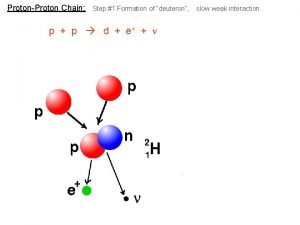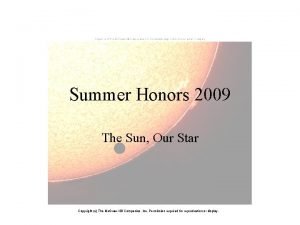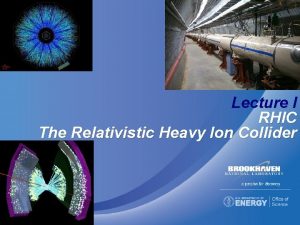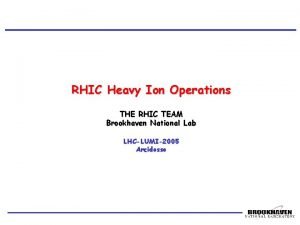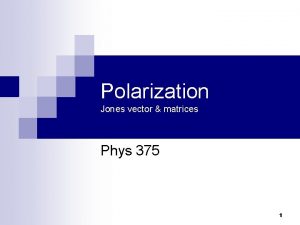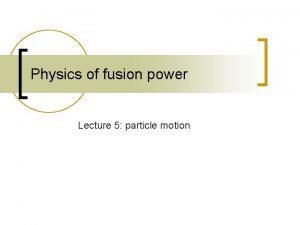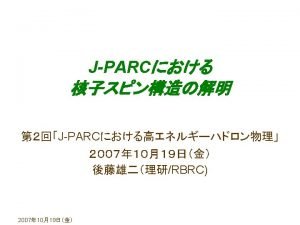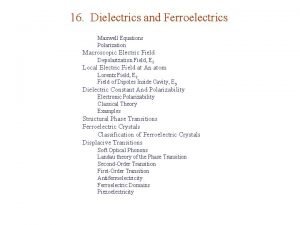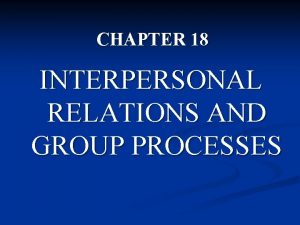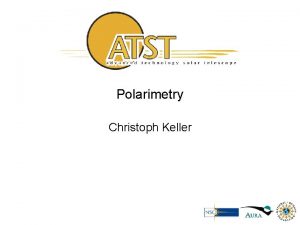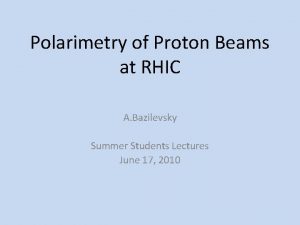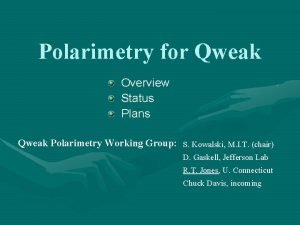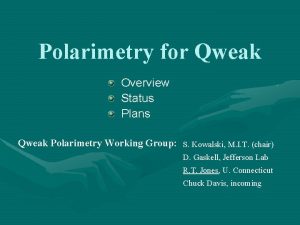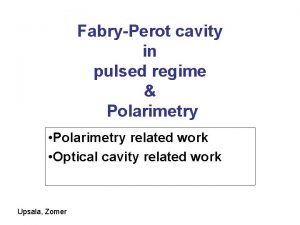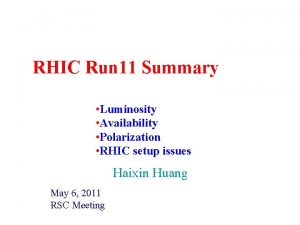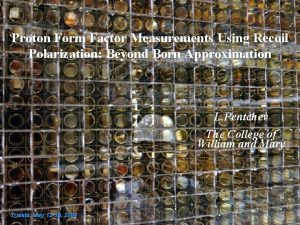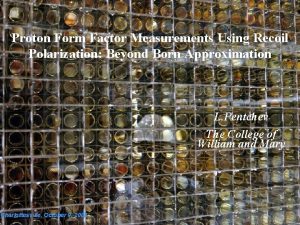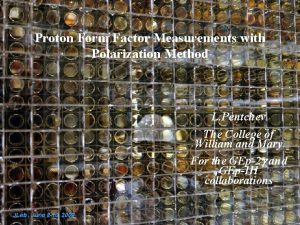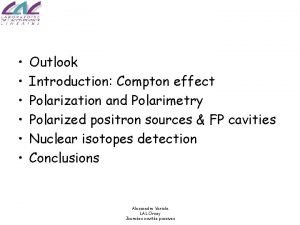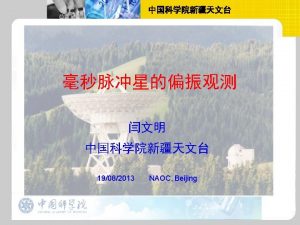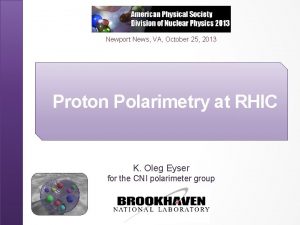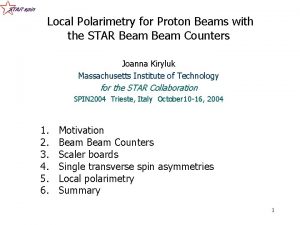Proton Polarimetry at RHIC 1 Provide polarization measurements





















- Slides: 21

Proton Polarimetry at RHIC 1. Provide polarization measurements for accelerator 2. Provide polarization measurements for experiments Alekseev, A. Bravar, G. Bunce, S. Dhawan, R. Gill, W. Haeberli, H. Huang, O. Jinnouchi, K. Kurita, Y. Makdisi, A. Nass, H. Okada, N. Saito, H. Spinka, E. Stephenson, D. Svirida, T. Wise, J. Wood, A. Zelenski DIS 2006 Tsukuba, April 21, 2006 Alessandro Bravar

Polarimetry : Impact on RHIC Spin Physics Single Spin Asymmetries Physics Asymmetries Double Spin Asymmetries measurements § measured spin asymmetries normalized by P to extract Physics Spin Observables § RHIC Spin Program requires DP / P ~ 0. 05 § normalization Þ scale uncertainty § polarimetric process with large s + sizable and known A B beam N – p. C elastic scattering in CNI region, AN ~ 1 – 2 % large statistics > 107 events – (very) large ´ - section fast measurements – requires absolute calibration polarized gas jet target DIS 2006 Alessandro Bravar

RHIC pp accelerator complex RHIC p. C “CNI” polarimeters absolute p. H polarimeter BRAHMS & PP 2 PP PHOBOS RHIC Siberian Snakes PHENIX STAR Siberian Snakes Spin Rotators 5% Snake LINAC Pol. Proton Source BOOSTER AGS 200 Me. V polarimeter 20% Snake DIS 2006 Rf Dipoles Alessandro Bravar AGS p. C “CNI” polarimeter

How It Works ? 0. 01 < |t| < 0. 02 (Ge. V/c)2 polarized beam Carbon target recoil Carbon t = (pout – pin)2 < 0 » Tkin × 2 MC Polarimetry: Requires large F. o. M: AN 2 x rate for fast measurement (not at any price however, i. e. by increasing the rates) small AN ~ 1 % (far from ideal !) Þ requires large statistics > 107, for d PB ~ few % however too large rates (i. e. thick target, detector area, etc. ) Þ occupancy and pileup Þ very difficult operation Þ corrections to measured asymmetries Þ larger systematic uncertainty Absolute calibration Þ Polarized Gas Jet target DIS 2006 Alessandro Bravar scattered proton

Setup for p. C scattering – the RHIC polarimeters inside RHIC ring @IP 12 beam direction 6 Ultra thin Carbon ribbon Target 1 (3. 5 mg/cm 2, 10 mm wide) 5 2 4 3 Si strip detectors (To. F, EC) 36 cm Beam direction all Si strips parallel to beam RHIC ´ 2 rings § recoil carbon ions detected with Silicon strip detectors § 2 ´ 72 channels read out with WFD (increased acceptance by 2) § very large statistics per measurement (~ 20 ´ 106 events) allows detailed analysis – – – bunch by bunch analysis channel by channel (each channel is an “independent polarimeter”) 45 o detectors: sensitive to vertical and radial components of Pbeam unphysical asymmetries DIS 2006 Alessandro Bravar

Event Selection & Performance TOF, ns Tkin= ½ MR(dist/To. F)2 Typical mass reconstruction MR ~ 11 Ge. V s. M ~ 1 Ge. V non-relativistic kinematics Carbon Prompts Alpha C* Prompts EC, ke. V Carbon MR, Ge. V - very clean data, background < 1 % within “banana” cut - good separation of recoil carbon from (C* + X) and prompts may allow going to very high |t| values - D (Tof) < ± 10 ns (Þ s. M ~ 1 Ge. V) - very high rate: 105 ev / ch / sec DIS 2006 Alessandro Bravar

p. C Systematics RHIC: each detector channel covers same t range 72 independent measurements of AN width ~ stat. error single meas. channel by channel raw asymmetry Fit with sine function (phase fixed) sources of systematic uncertainties: 1 D PBEAM = 8. 5 % (normalization) [PBEAM = 0. 386 ± 0. 029 ± 0. 016] 2 energy scale ~ 50 ke. V for lowest |t| bin (from detector dead layer) NB these are “external” factors not “intrinsic” limitations DIS 2006 Alessandro Bravar

DAQ and WFD Wave Form Digitizer = peak sensing ADC, CFD, … common to the p. C and JET DAQ system ~50 ns ADC 3´ 140 MHz ~100 m. V FPGA Dt ~ 2 ns DE < 50 ke. V synchronized to accelerator clocks bunch ´-ing Þ “start” TDC “online” analysis of waveform performed beteween consecutive bunch ´-ing ÞPH, tot Q, t. o. f. ; full waveform (JET) onboard memory DAQ PC 20 ´ 106 events in 20 seconds Þ deadtimeless DAQ system can accept, analyze, and store 1 event / each bunch ´-ing DIS 2006 Alessandro Bravar

raw asymmetry = AN · PB AGS polarization during acceleration (ramp) depolarizing resonances: intrinsic: Gg =12+n imperfection: Gg = n DIS 2006 each point = 50 Me. V step 36 -n Gg = 1. 91 Ebeam 48 -n 36+n red line: simulation of polarization losses assuming constant AN Alessandro Bravar

Bunch by Bunch 110 bunches typical example sometime even nicer than in textbooks DIS 2006 Alessandro Bravar

Bunch by Bunch + Spin Patterns high statistics 28 bunches @ injection 110 bunches @ flattop 1011 p / bunch 110 bunches @ flattop with messed spin pattern DIS 2006 Alessandro Bravar

Beam Polarization Profiles … 2 mm to avoid target location dependencies, sweep the target through the beam => “average” bunch polarization intensity profile DIS 2006 Alessandro Bravar

Beam Emittance by sweeping the carbon target through the beam ~ 1 sec. measurement DIS 2006 Alessandro Bravar

The Road to Pbeam with the JET target Requires several independent measurements 0 JET target polarization Ptarget (Breit-Rabi polarimeter) 1 AN for elastic pp in CNI region: AN = 1 / Ptarget e. N’ 2 Pbeam = 1 / AN e. N” 1 & 2 can be combined in a single measurement: Pbeam / Ptarget = e. N’ / e. N” “self calibration” works for elastic scattering only 3 CALIBRATION: ANp. C for p. C CNI polarimeter in covered kinematical range: ANp. C = 1 / Pbeam e. N”’ (1 +) 2 + 3 measured simultaneously with several insertions of carbon target 4 BEAM POLARIZATION: Pbeam = 1 / ANp. C e. N”” to experiments at each step pick-up some measurement errors: expected precision transfer DIS 2006 calibration Alessandro Bravar measurement

JET Target ANbeam (t ) = ANtarget (t ) for elastic scattering only! Pbeam = Ptarget. e. Nbeam / e. Ntarget B DIS 2006 Alessandro Bravar

JET target polarization & performance the JET ran with an average intensity of 1´ 1017 atoms / sec the JET thickness of 1 ´ 1012 atoms/cm 2 record intensity target polarization cycle +/0/- ~ 500 / 500 sec polarization to be scaled down due to a ~3% H 2 background: Ptarget ~ 0. 924 ± 0. 018 (current understanding) no depolarization from beam wake fields observed ! DIS 2006 Alessandro Bravar

Number of elastic pp events pp elastic data collected To. F vs EREC correlation Tkin= ½ MR(dist/To. F)2 recoil protons elastic pp pp scattering JET Profile: measured selecting pp elastic events FWHM ~ 6 mm as designed background 118 cts. subtracted D To. F < ± 8 ns T Kin [Me. V] Hor. pos. of Jet 10000 cts. = 2. 5 mm CNI peak AN 1 < E REC < 2 Me. V prompt events and beam-gas source calibration • recoil protons unambiguously identified ! • 100 Ge. V ~ 1. 8 ´ 106 events for 1. 5 ´ 10– 3 < -t < 1. 0 ´ 10– 2 Ge. V 2 similar statistics for 1. 0 ´ 10– 2 < -t < 3. 0 ´ 10– 2 Ge. V 2 • 24 Ge. V ~ 300 k events DIS 2006 Alessandro Bravar

Energy - Position correlations 4 - 36 mm 1– 8 not used Energy number of events (a. u. ) Tkin µ q 2 (i. e. position 2) 11 – 18 pp elastic events clearly identified ! DIS 2006 Position Alessandro Bravar

Event selections & Backgrounds Strip distribution for energy interval: 1250 – 1750 ke. V signal background Si #2 Si #6 implement the energy / angle correlation in selecting elastic pp events typically, for each energy bin, select 3 to 4 strips per detector Background only from selected channels not from whole detector (4 – 5 ´ smaller !) Total Backgrounds < 8 %: source < 4%, “interaction” backgrounds < 4 % DIS 2006 Alessandro Bravar

PBEAM … “self calibrating” ratio e. B / e. T “Target”: e. T – target asymmetry average over beam polarization “Beam”: e. B – beam asymmetry average over target polarization reduced c 2 ~ 1 tot sys = 0. 016 PBEAM = 0. 392 ± 0. 021 (stat) ± 0. 008 (D PTARGET) ± 0. 014 (sys) = 0. 392 ± 0. 026 2004 ERROR: D PBEAM / PBEAM = 6. 6 % 2005, 2006: in progress D PBEAM / PBEAM < 5 % ! DIS 2006 Alessandro Bravar

Summary § fast measurements of P in ~ 30 sec. § provides also information on beam properties § steady progress in understanding and addressing systematic issues § “online” precision ~ 10 % (relative) § absolute normalization with a polarized gas JET § during 2004 run with Jet target precision on beam polarization beam D PBEAM / PBEAM = 6. 6 % 2005 – 2006 (in progress): D PBEAM / PBEAM < 5 % ! DIS 2006 Alessandro Bravar
 Polarimetry definition in chemistry
Polarimetry definition in chemistry Biots law polarimetry
Biots law polarimetry Polarimetry organic chemistry
Polarimetry organic chemistry Proton proton chain
Proton proton chain Proton proton chain
Proton proton chain Proton proton chain
Proton proton chain Rhic
Rhic Rhic
Rhic Rhic brookhaven
Rhic brookhaven Rhic ags users meeting 2020
Rhic ags users meeting 2020 Group polarization psychology definition
Group polarization psychology definition Diffraction and polarization
Diffraction and polarization Group polarization vs groupthink
Group polarization vs groupthink Half wave plate jones matrix
Half wave plate jones matrix Altruism psychology
Altruism psychology Group aggression
Group aggression Photon polarization
Photon polarization Polarization drift
Polarization drift Depolarization factor
Depolarization factor Group polarization example
Group polarization example Polarization catastrophe in ferroelectrics
Polarization catastrophe in ferroelectrics Group polarization vs groupthink
Group polarization vs groupthink
